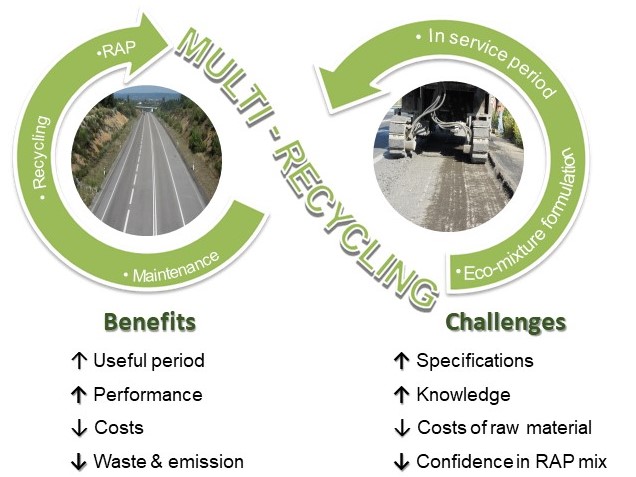Circular Materials
Circular Materials Management has revolutionized construction and infrastructure practices by prioritizing sustainability and resource efficiency. By embracing circular economy principles, we shift away from the outdated linear model of “take, make, dispose” towards a more sustainable approach. Reusing materials becomes paramount, extending their lifespan and reducing the need for virgin resources. Incorporating recycled materials into new solutions not only minimizes waste but also reduces carbon emissions associated with resource extraction and production.

Furthermore, prioritizing renewable resources in construction processes have helped to mitigate the carbon footprint of infrastructure development. By opting for sustainable alternatives such as reclaimed asphalt pavement, hemp fibres, brewery spent grains, or recycled aggregates, we lessen our reliance on finite resources while promoting environmental stewardship. These materials not only offer comparable performance but also contribute to preserving natural habitats and biodiversity.
Incorporating circular materials management practices into construction and infrastructure projects not only enhances climate resilience but also fosters economic opportunities and innovation. It stimulates the development of new recycling technologies, promotes local sourcing and production, and encourages collaboration across sectors to create closed-loop systems. Ultimately, by embracing circularity, we pave the way for a more sustainable future, where resource efficiency and environmental protection go hand in hand.
Main Publicações
- Antunes, V.; Neves, J.; Freire, A. C. (2023). Could high RAP mixtures be multi-recycled? Validation through long-term performance assessment. Transportation Engineering Journal, Vol. 14, pp. 100215. DOI 10.1016/j.treng.2023.100215
- Antunes, V.; Moreno, F.; Rubio-Gámez, M.; Freire, A.C.; Neves, J. (2022). Assessing RAP Multi-Recycling Capacity by the Characterization of Recovered Bitumen Using DSR. Sustainability Journal, Vol. 14, pp. 1-17. DOI 10.3390/su141610171
- Antunes, V.; Neves, J.; Freire, A.C. (2021). Performance Assessment of Reclaimed Asphalt Pavement (RAP) in Road Surface Mixtures. Recycling Journal, Vol. 6, pp. 1-19. DOI 10.3390/recycling6020032
- Antunes, V.; Freire, A.C.; Neves, J. (2021). Investigating aged binder mobilization and performance of RAP mixtures for surface courses. Construction and Building Materials Journal, Vol. 271, pp. 121511. DOI 10.1016/j.conbuildmat.2020.121511
- Vandewalle, D.; Antunes, V.; Neves, J.; Freire, A.C. (2020). Assessment of Eco-Friendly Pavement Construction and Maintenance Using Multi-Recycled RAP Mixtures. Recycling Journal, Vol. 5, pp. 1-21. DOI 10.3390/recycling5030017
- Antunes, V.; Freire, A.C.; Neves, J. (2019). A review on the effect of RAP recycling on bituminous properties and viability of multi-recycling. Construction and Building Materials Journal, Vol. 2011, pp. 1045-1053. DOI 10.1016/j.conbuiltmat.2018.09.063
- Pereira, L.; Freire, A.C.; Sá da Costa, M.; Antunes, V. (2018). Experimental study of the effect of filler on the ductility of filler-bitumen mastics. Construction and Building Materials Journal, Vol. 189, pp. 1045-1053. DOI 10.1016/j.conbuiltmat.2018.09.063
- Antunes, V.; Simão, N.; Freire, A.C. (2017). A Soil-Cement Formulation for Road Pavement Base and Sub Base Layers: a Case Study. Transportation Infrastructure Geotechnology Journal, Vol. 4 (2017), pp. 126-141. DOI: 10.1007/s40515-017-0043-9
- Antunes, V.; Freire, A.C.; Quaresma, L.; Micaelo, R. (2017). Evaluation of waste materials as alternative sources of filler in asphalt mixtures. Materials and Structures RILEM Journal, Vol.50. DOI 10.1617/s11527-017-1126-3
